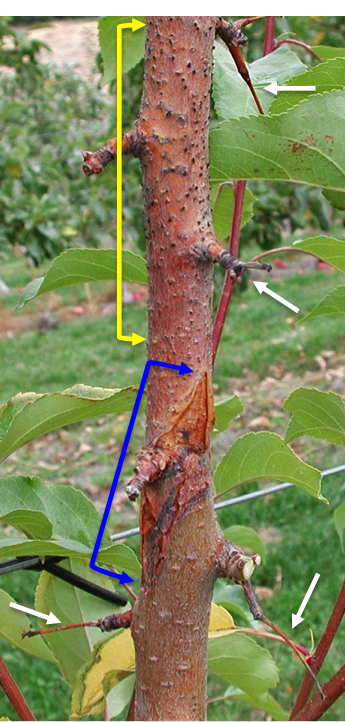Speck Rot of Apples
Casual Organism
Speck rot, a postharvest fruit rot disease of apple, is caused by the pathogenic fungus Phacidiopycnis washingtonensis. Fruit infection originates in the orchard. The source of the inoculum comes from dead or diseased plant tissue of the ‘Manchurian’ crabapple pollinizers in affected orchards. The fungus produces small black dots (fruiting bodies = pycnidia) on ‘Manchurian’ twigs, tree branches and crabapple fruit. Fruiting bodies contain millions of infective spores that can be spread by rain, irrigation or over-tree cooling to nearby apple trees and fruit. Although apple fruit infection occurs in the orchard, fruit rot symptoms develop during storage or at the market.
The cankers and twig dieback caused by P. washingtonensis are not common on apple trees in commercial apple orchards in Washington State, but the ‘Manchurian’ crabapple pollinizer trees are highly susceptible. Detailed pruning of this pollinizer is strongly recommended to significantly reduce the infective potential in commercial orchards.
Symptoms
Orchard symptoms
The pathogen is associated with dead tissues on apple trees. It can also cause twig dieback and canker disease of the crabapples used as pollinators. P. washingtonensis is a weak canker pathogen to apple trees. The fungus causes small black dots (fruiting bodies) to form on infected twigs and tree branches. Fruiting bodies contain millions of spores which serve as inoculum for fruit infection. The fungal spores are then spread by rain, irrigation water or over- tree cooling.
Postharvest fruit symptoms
Speck rot symptoms can also occur as either a stem-end rot, as a calyx-end rot, or both. The affected fruit tissue is spongy to firm, which is not differentiable from gray mold and not readily separable from the healthy tissue. The color of the decayed area varies from light brown to dark brown, or occasionally black. Speck rot is so named because the brown to black specks with white to light tan centers that may appear around the lenticels, especially on red apple cultivars.
Control
Orchard disease management
Since the major source of inoculum comes from infected crabapple (both dead tissues of trees and fruit mummies), pruning is highly recommended to reduce infection by P. washingtonensis. Detailed pruning to remove all infected twigs, branches and fruit mummies will significantly reduce infection by these pathogens. Any approach to pruning that still leaves a considerable amount of infected tissues should be reconsidered. However, any amount of pruning is preferable to leaving trees unpruned. A video on the preferred method of pruning for pathogen management can be found here: Managing quarantine-significant postharvest diseases in PNW apple and pear orchards.

Water spreads the fungal inoculum and creates conditions conducive for fruit infection. Terefore, it is recommended that overhead irrigation be avoided and that over-tree cooling be limited in duration to only the amount necessary for sunburn prevention.
Preharvest fungicides such as Ziram, Topsin M or Pristine applied near harvest as a ground application reduce speck rot caused by P. washingtonensis. Good coverage is important to the effectiveness of preharvest fungicide sprays.
Postharvest disease management
A postharvest fungicide drench with Penbotec (pyrimethanil), Scholar (fludioxonil) is highly effective in controlling this disease on apple fruit. A postharvest drench with Mertect (thiabendazole) is also effective. These three postharvest fungicide treatments are more effective than the preharvest fungicide sprays.



